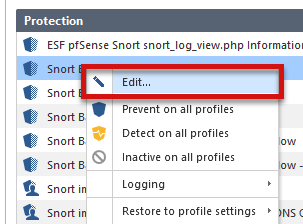

#SNORT X DOWNLOAD#
Snort 2.6.1.3 is available from the Snort download site.
#SNORT X CODE#
Further information is available in advisories from Sourcefire and ISS.Ī remote, unauthenticated attacker may be able to execute arbitrary code with the privilege level of the Snort preprocessor. This vulnerability has been assigned CVE number CVE-2006-5276. US-CERT is tracking this vulnerability as VU#196240. The DCE/RPC preprocessor is enabled by default, and it is not necessary for an attacker to complete a TCP handshake. An attacker could exploit this vulnerability by sending a specially crafted TCP packet to a host or network monitored by Snort. The vulnerable code does not properly reassemble certain types of SMB and DCE/RPC packets. The DCE/RPC preprocessor reassembles fragmented SMB and DCE/RPC traffic before passing data to the Snort rules. Snort and its components are used in other IDS products, notably Sourcefire, and Snort is included with a number of operating system distributions. To learn more about Snort and its capabilities visit Snort.Sourcefire Snort is a widely-deployed, open-source network intrusion detection system (IDS).
#SNORT X FOR MAC OS X#
If your interested in security this is a must for Mac OS X users. Programs on the windows platform cost up to $5000.00. One of the great things about Snort is it is BSD compatible so Mac OS X users may use this free program to run network intrusion tests.
#SNORT X INSTALL#
We are sure to see a Mac OS X install package in the near future for this application for now you have to be a little unix savvy. There you will download either the source or the RPM, and compile or install. Because unix based development has updates and changes often the link below goes directly to their download area.

Snort is a open source project and remains free to the user. If you want to watch for something specific you may create your own snort rule file and snort will monitor it for you. By looking the Snort website and reading the Current Snort Rule file you will see the flexibility of the definitions. For example: log tcp x.x.x/xx OR log tcp x.x.x/xx any -> xxx (msg: some command) All rules should contain a rule header (which identifies the actions) and rule options (which identify the rule’s alert messages). The rules are what Snort looks for, like virus definition files it defines what to watch for. Snort rules must be contained in a single line or we can use the multi-line character. Setting up is simple, once unpacked read through the documentation, that is where you will find information on installing and using Snort. Sounds kind of complicated to some people, there isn’t a Graphical User Interface for this program on the Mac OS X yet so it is command line. Snort should work any place libpcap does, and is known to have been compiled successfully for Mac OS X server. Snort logs packets in either tcpdump(1) binary format or in Snort’s decoded ASCII format to logging directories that are named based on the IP address of the “foreign” host
#SNORT X FULL#
It can be used as a straight packet sniffer like tcpdump(1), a packet logger (useful for network traffic debugging, etc), or as a full blown network intrusion detection system. Snort has a real-time alerting capability as well, incorporating alerting mechanisms for syslog, a user specified file, a UNIX socket, or WinPopup messages to Windows clients using Samba’s smbclient. Snort uses a flexible rules language to describe traffic that it should collect or pass, as well as a detection engine that utilizes a modular plugin architecture. It can perform protocol analysis, content searching/matching and can be used to detect a variety of attacks and probes, such as buffer overflows, stealth port scans, CGI attacks, SMB probes, OS fingerprinting attempts, and much more. Snort is a lightweight network intrusion detection system, capable of performing real-time traffic analysis and packet logging on IP networks. Snort – Network Intrusion Detection System on Mac OS X Information


 0 kommentar(er)
0 kommentar(er)
